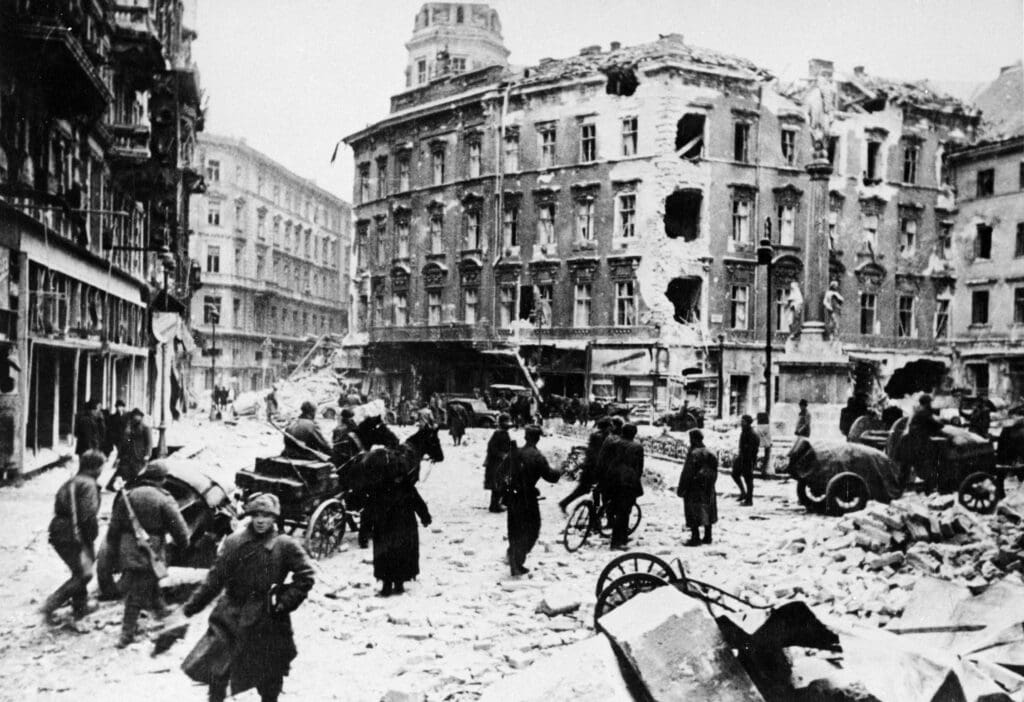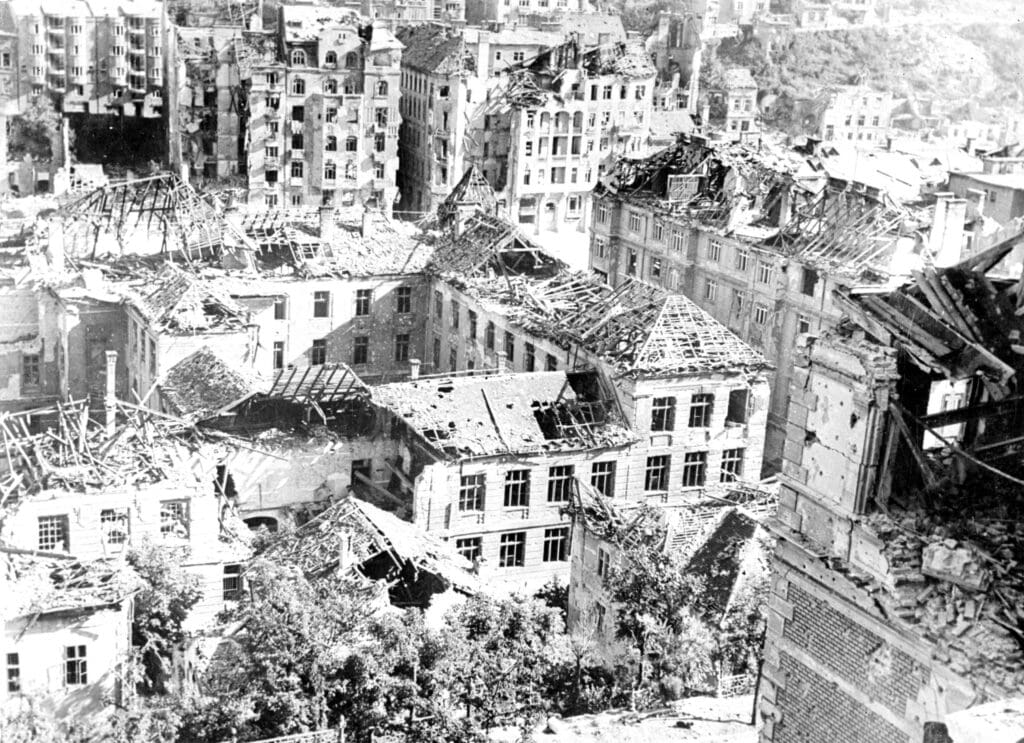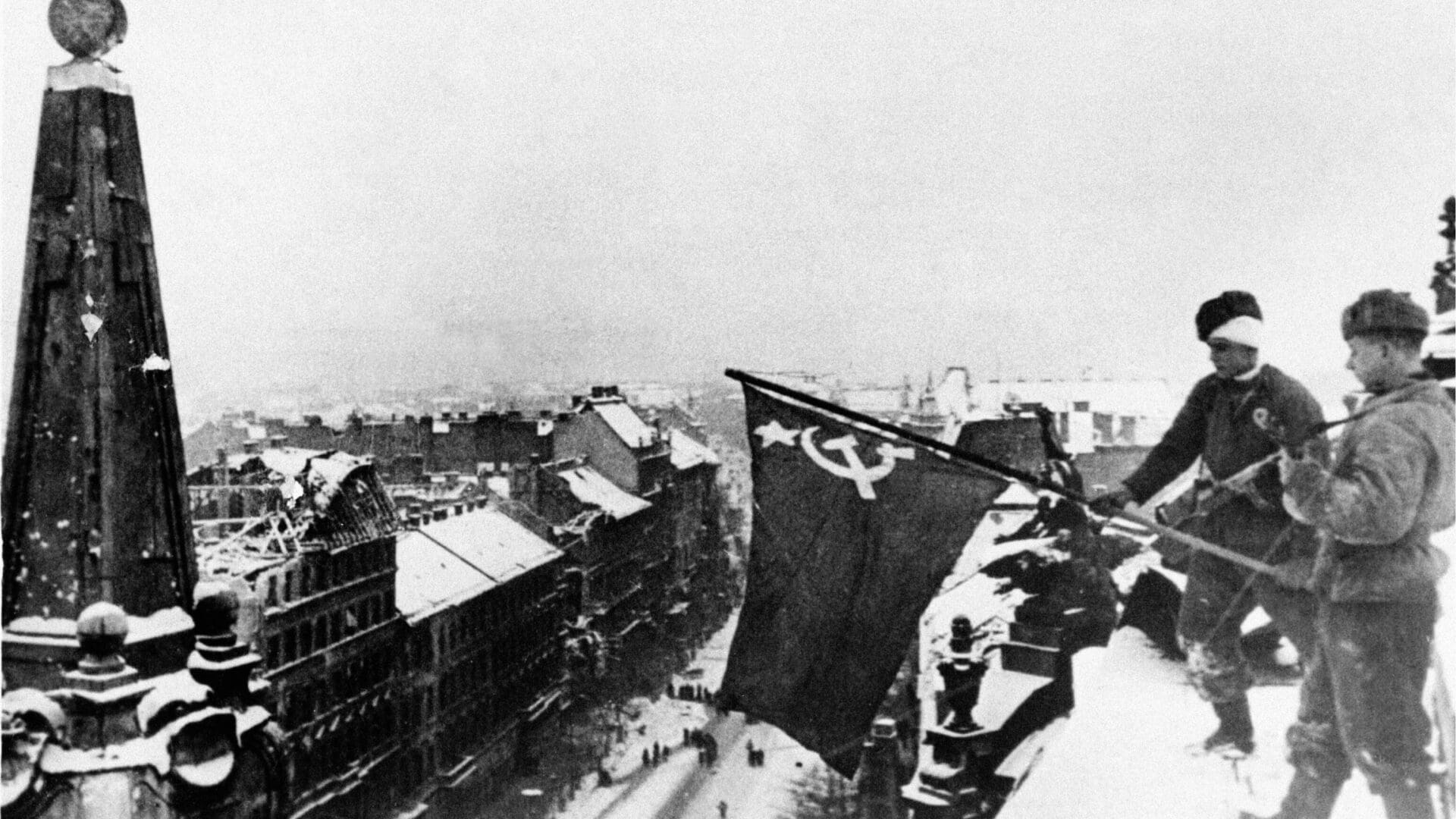The Siege of Budapest lasted from November 1944 to February 1945, and is considered one of the most dramatic and bloody battles of the Second World War.
Budapest Fortress
When the Soviets approached Budapest in November, Stalin thought that he could take the city swiftly, just like he took Bucharest and Sofia. But in Romania and Bulgaria, anti-Axis political forces took power before a siege would start, and switched sides during the conflict. As opposed to that, Hungary was under the leadership of the pro-Nazi Arrow Cross Party and the puppet government of Germany. Furthermore, many Hungarians were also against surrendering, since Soviet troops had a (rightfully) dreadful reputation of engaging in cruelty, rapine, and rape. The German and Hungarian military leadership thus declared Budapest a ‘fortress’, meaning that it was to be defended at all cost. Hitler speculated that if the siege delays the war long enough, it may turn the tide, just as the Soviet endurance at Stalingrad did.
Therefore, Germans and Hungarians strengthened their defences inside and around the city. Iván Hindy, the Hungarian commander of the defending forces, was in practice subordinated to Karl Pfeffer-Wildenbruch, the German commander. The Hungarian leadership was essentially tasked merely with securing supplies for the defenders. A line of defence, the ‘Attila Line’, was created around the city, especially in the mountains of Buda, which indeed held up the Soviet forces for a while. In fact, the Soviets were forced to relocate some of their forces toward Buda to be able to break the line of defence. On 20 November, a desperate push was initiated by the Soviets to encircle Budapest. After more than a month of fierce fighting, it succeeded on 24 December. On Christmas Eve, the nearly 100,000 defenders were encircled by more than 140,000 Soviet and Romanian troops.
The Siege Commences
The Soviets arrived at the gates of Budapest from the East, so they first engaged the Axis forces on the Pest side. By Christmas Day, the Red Army reached the Buda as well. Thus, many inhabitants of both parts of the capital were forced to seek refuge in underground air-raid shelters as the heavy shelling started. The city was encircled, and laid under siege.
The actual fighting inside Budapest started on 30 December,
after the defenders of the city declined the Soviet ultimatum of unconditional surrender the day before. The siege was opened by an intense artillery barrage, followed by, in the next days, an offensive. The Soviet forces rapidly achieved huge territorial gains in the southern and eastern outskirts of Pest, not all of which were legally part of the city that time. During the first weeks of January, the Soviets focused on Pest, with their forces advancing toward the inner parts of the city, and consolidating their grip on the outskirts, such as the Kőbánya quarter (10th district) during the first days of the month.
The final offensive started on 17 January, and Pest fell the next day.

To prevent the Soviets from crossing over to Buda, the Germans detonated most bridges over the Danube. That, however, did not stop the Soviets from attack the encircled Buda side from the mountains, and some units even managed to cross the river from Pest.
The Soviets on the Pest side set up Communist authorities, which immediately started to prosecute the purported or real war criminals, as well as their political opponents. However at least the authorities also reorganized the normal life in that part of the city. The Soviets on the other hand raped and looted, as well as abducted civilians. Many people were taken to Siberia for hard labour, a phenomenon known in Hungary as ‘malenkaya rabota’ (‘маленькая работа’), meaning ‘little work’, since the Soviets promised the apprehended people to be released soon, hinting to be only used to clear the city from the war damage. However, most of them were held in labour camps for many years.
The Battle for Buda
After 17 January, the Soviets concentrated on the siege of Buda. During most of the month, the epicentre of the fighting were the Városmajor and Vérmező parks of Krisztinaváros, with Vérmező being used as a makeshift airport by the defenders. By the end of January, the Soviets occupied most of this area, disrupting German landings. Thus, supplies of munitions and food were cut off, putting both soldiers and civilians, especially the wounded ones, in a desperate situation. The military leadership was aware that resistance was unsustainable. Yet, Hungarian forces, now consisting mostly of civilians and secondary school students, launched a last offensive to retake Vérmező on 26 January, which was repulsed by the Soviets. This stabilized the frontlines, but obviously did not improve the abysmal conditions of the defenders and the civilians. Many advocated for surrender, but Hitler was adamant and ordered the troops to fight until the end.
But the German and Hungarian military leadership decided on a third option.
On 11–12 February, the assembled joint forces, approaching 10,000, attempted to break through the Soviet lines at the edge of Buda. It was a risky operation, leading to bloodshed and high Axis casualties. Yet, near a thousand troops survived and reached the German lines. Since due to this risky action, all of the defenders were either dead, gravely wounded, or left the city by 13 February, the battle ended on that day, marking the end of the siege and battle of Budapest.
The siege cost 70,000 lives on the part of the defenders, while 48,000 Soviet and Romanian soldiers fell. 38,000 civilian also lost their lives during the fighting, including 17,000 Jews, who were often massacred by Arrowed Cross Party militias, which infamously shot them into the Danube. While the inhabitants of the Budapest ghetto escaped deportation to Nazi concentration camps, they lived in terrible conditions, and were subject to frequent roundups and executions, as well as looting, torture, and rapes.
The siege also reduced the city to rubble, with only a quarter of the buildings of Budapest remaining intact.

Conclusion
The siege caused devasting damage to the capital city, both in terms of lives lost and buildings and infrastructure destroyed, with many edifices bearing the marks of the fighting to this very day. It also extended the suffering of the Jewish population. On the other hand, the long siege stalled the advance of the Soviets toward Western Europe. While it is know that the Western Allies later stopped the advance at the Elbe, as it had been agreed earlier between them and Stalin, it is not entirely certain that the Soviets would not have advanced beyond that line had they reached it before the Americans. Also, while it is true that Hitler was determined to force the Hungarians to fight until the very end, and thus there was little room for free choice, many Hungarians were also keen on resisting the Communist forces for as long as possible, with many feared what Soviet rule might look like, with their fears being fuelled by news about the treatment of civilians in Russian-occupied territories. These fears were unfortunately confirmed by the behaviour of the Soviet troops towards the civilian population.
Under the shadow of Soviet bayonets, the Communist soon took over in the capital city and in the entire country. 11 years later, however, the citizens of Budapest took up arms again against them and the occupying Russian forces—and Budapest once again became a war zone.








